

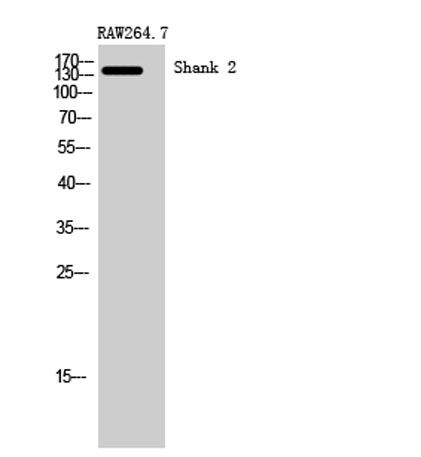
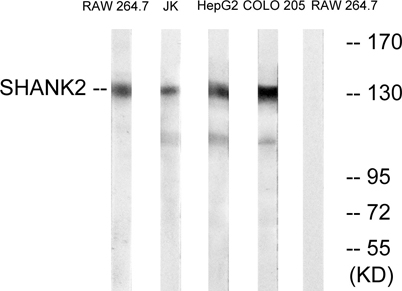
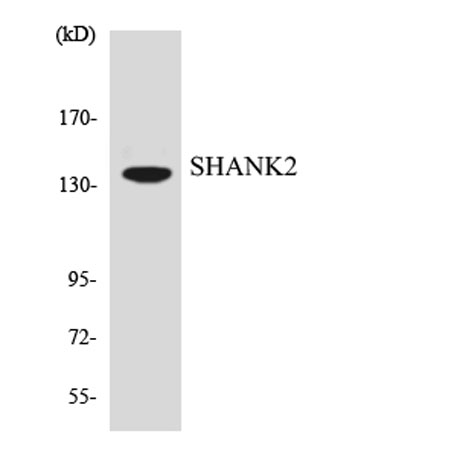
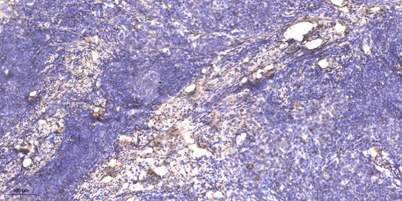
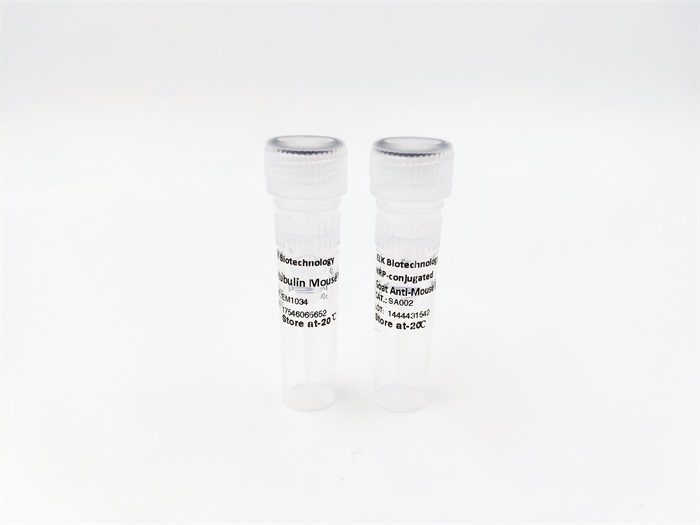



Shank 2 rabbit pAb
 One-click to copy product information
One-click to copy product information$148.00/50µL $248.00/100µL
| 50 µL | $148.00 |
| 100 µL | $248.00 |
Overview
| Product name: | Shank 2 rabbit pAb |
| Reactivity: | Human;Rat;Mouse; |
| Alternative Names: | SHANK2; CORTBP1; KIAA1022; SH3 and multiple ankyrin repeat domains protein 2; Shank2; Cortactin-binding protein 1; CortBP1; Proline-rich synapse-associated protein 1 |
| Source: | Rabbit |
| Dilutions: | WB 1:500-2000;IHC-p 1:50-300 |
| Immunogen: | The antiserum was produced against synthesized peptide derived from human SHANK2. AA range:331-380 |
| Storage: | -20°C/1 year |
| Clonality: | Polyclonal |
| Isotype: | IgG |
| Concentration: | 1 mg/ml |
| Observed Band: | 135kD |
| GeneID: | 22941 |
| Human Swiss-Prot No: | Q9UPX8 |
| Cellular localization: | Apical cell membrane . Cytoplasm . Cell junction, synapse . Cell junction, synapse, postsynaptic density . Cell projection, growth cone . Cell projection, dendritic spine . Colocalizes with cortactin in growth cones in differentiating hippocampal neurons. Colocalized with PDE4D to the apical membrane of colonic crypt cells (By similarity). . |
| Background: | This gene encodes a protein that is a member of the Shank family of synaptic proteins that may function as molecular scaffolds in the postsynaptic density of excitatory synapses. Shank proteins contain multiple domains for protein-protein interaction, including ankyrin repeats, and an SH3 domain. This particular family member contains a PDZ domain, a consensus sequence for cortactin SH3 domain-binding peptides and a sterile alpha motif. The alternative splicing demonstrated in Shank genes has been suggested as a mechanism for regulating the molecular structure of Shank and the spectrum of Shank-interacting proteins in the postsynaptic densities of the adult and developing brain. Alterations in the encoded protein may be associated with susceptibility to autism spectrum disorder. Alternative splicing results in multiple transcript variants. [provided by RefSeq, Feb 2014], |
-
 Western Blot analysis of RAW264.7 cells using Shank 2 Polyclonal Antibody
Western Blot analysis of RAW264.7 cells using Shank 2 Polyclonal Antibody -
 Western blot analysis of lysates from RAW264.7, Jurkat, HepG2, and COLO cells, using SHANK2 Antibody. The lane on the right is blocked with the synthesized peptide.
Western blot analysis of lysates from RAW264.7, Jurkat, HepG2, and COLO cells, using SHANK2 Antibody. The lane on the right is blocked with the synthesized peptide. -
 Western blot analysis of the lysates from HT-29 cells using SHANK2 antibody.
Western blot analysis of the lysates from HT-29 cells using SHANK2 antibody. -
 Immunohistochemical analysis of paraffin-embedded human cervical carcinoma. 1, Antibody was diluted at 1:200(4° overnight). 2, Tris-EDTA,pH9.0 was used for antigen retrieval. 3,Secondary antibody was diluted at 1:200(room temperature, 45min).
Immunohistochemical analysis of paraffin-embedded human cervical carcinoma. 1, Antibody was diluted at 1:200(4° overnight). 2, Tris-EDTA,pH9.0 was used for antigen retrieval. 3,Secondary antibody was diluted at 1:200(room temperature, 45min).

 Manual
Manual